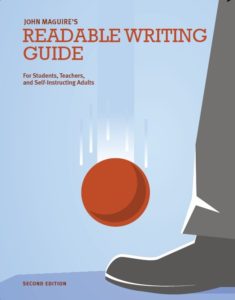Dear John,
I’m a high school English teacher from Singapore. I read your post about using concrete nouns in writing in The Atlantic. It sounds like a great idea, but I’m a bit at a loss as to how to actually teach students to do that. Could you give some examples of what writing with concrete nouns actually looks like?
Sincerely,
Laura O.
**
Dear Laura–
It has been proven that teaching grammar alone (parts of speech, etc) does nothing to improve writing. My friends in the research business tell me that.
But embedding grammar inside lessons on communicating really works. If students are learning to write clearly and want to write clearly, basic grammar ideas can be taught and will be assimilated.
My course teaches a few very useful grammar and stylistic distinctions, always within the context of readable writing. I have trimmed the course so that it covers the smallest number of grammar ideas that will do the trick. Keeping things simple is the key to self-control; writing is about self-control on the page; therefore, to achieve simplicity, I keep the number of entities to be learned tiny.
(Before going further, I want to credit the late and brilliant Rudolf Flesch, who penetrated and fully explained what constituted readability in The Art of Readable Writing. About half of my method is a direct steal from him, and the other half is a logical extension of his ideas.)
My course requires the mastery of five aspects of style, five variables. Mastery of these five variables (you could call them writing sub-skills) gives students total control over what they write and the ability to be vivid and clear at will. Reduced to brief rules of thumb they are:
1. Concrete nouns
2. Active verbs
3. Dramatic or human focus
4. Short sentences on average
5. Short words chosen over long
The College Writing Guide explains these rules with a lot of detail and gives exercises to be used in class and as homework.
In the course I cover the five rules in depth, taking about eight weeks for the five rules-skills-variables. Verbs are a complex grammar idea, so I spend four weeks (12 class meetings) on them. When they reach week 9 of the course, students are required to perform all five skills at once. That is, they must write short essays that have concrete objects, people and active verbs in them. They must use short sentences on average, and they must use shorter words rather than long ones. (Another requirement not listed above is conciseness—no fluff is permitted.)
To get to your question, the way to get students to write with objects is to add that requirement to any assignment you already use. Write [X number of] words on (1) a person you love or hate or admire, (2) a book you want me to read, (3) the definition of home or friendship, (4) a happy memory you think of often. Within that word count, maintain a proportion of one concrete object for every 20 total words.
This kind of assignment does a lot. It calls student attention to objects by requiring that they be included, activates his memory and imagination, and tells the student to take responsibility for monitoring the concreteness of his own writing by inspecting the ratio of objects to all words.
And it produces good, visual writing.
The other four skills are handled in much the same way, using specific assignments with ratios as targets. You’ll find more in the textbook.
Sincerely,
John G. Maguire

